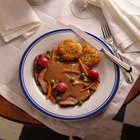istetiana/iStock/GettyImages
This Modern Technique Gives Outstanding Results
You won't often see a rib roast described as "semi-boneless" in the store, because old-school rib roasts - with the thick, heavy chine bone still attached - are a distant, fading memory. That thick ridge of bone made it difficult to carve the roast, so it's now customarily removed to leave just the rib bones themselves. The best way to get a perfectly cooked rib roast, with a tender interior and well-crusted exterior, is to cook it at low temperature and then finish it with an intense blast of heat.
Take the prime rib out of the refrigerator at least an hour before you plan to cook it. Blot it dry with paper towels, then pat sea salt or coarse kosher salt all over its surface and set it aside on the kitchen counter or return it to the fridge. It takes at least an hour for the salt to draw moisture from the beef and then be reabsorbed into the roast along with those juices, which means the salt seasons the interior of the meat rather than just the surface.
Set an oven rack one tier below the middle so your rib roast is approximately centered in the oven during cooking. Set your oven to 200 degrees Fahrenheit to preheat during the last 15 minutes of its time sitting on your counter.
Coat the surface of the beef to taste with freshly cracked black pepper or other desired seasonings, or let the flavor of the beef stand on its own. Other ingredients to use include dried rosemary or thyme, garlic or onion powder or a pre-mixed meat rub.
Place the prime rib on the rack of a sturdy roasting pan with the ribs down and the fat-side facing up. Put it onto the pre-set oven rack. Cook it for about 3 to 4 hours, with the cooking time varying considerably, depending upon the size of your rib roast. Starting at about 2 1/2 hours in for a three-rib roast or 3 hours in for a six-rib roast, monitor the internal temperature of the beef with an instant-read meat thermometer.
Remove your roast from the oven as soon as it hits 135 F if you want to serve it at medium doneness, with a final temperature of 145 F, as recommended by the U.S. Department of Agriculture. If you prefer your roast rare to medium-rare, remove it from the oven when it reaches an internal temperature of 120 F.
Turn the oven temperature up to its highest setting -- 500 or 550 F -- while resting the semi-boneless rib roast on a serving platter. During resting, its temperature continues to rise, and its internal juices settle.
Put the meat back on the rack of the roasting pan and return it to the middle of the oven after about 20 minutes. Cook it for about 6 to 10 minutes, just until the outside develops a crisp browning. Take it out and return it to the platter before serving.
Related Articles
How to Cook an English Cut Beef Chuck ...

How to Convection Roast a Brisket
How to Cook a Spencer Roast

How to Cook a Beef Topside Roast

How to Cook Prime Rib With a Kosher ...
How to Cook Sirloin Filets in a Pan and ...

How to Roast a Pork Blade Cut

How to Prepare Chuck Tender Roast

How to Slow Cook a Rolled Rib of Beef
How to Cook a Beef Hind Shank in a Slow ...

How to Cook Prime Rib Using an Oven ...
How to Cook a Choice Chuck Roast

How to Bake a Pork Loin Center Half

How to Cook a 15-Pound Rib Roast

How to Slow Cook an Eye of Round Roast ...

How to Cook Angus Beef in the Oven

How to Cook a Beef Roast in a Roaster ...
How to Slow Cook a Pot Roast With Beef ...
The Baking Instructions for Fillet ...

How to Cook Veal Sirloin
References
Resources
Tips
- Some cooks prefer to cook a semi-boneless beef rib roast to a different temperature than that recommended by the USDA. If you want yours rare, take it out of the oven the first time at 110 F for a final temperature of 120 F; for medium-rare, take it out initially at 120 F for a final temperature of 130 F; for medium-well, take it out at 140 F for a final temperature of 150 F; and for well-done, take it out at 150 F for a final temperature of 160 F.
- Use the meat's drippings in the bottom of the roasting pan for flavoring a sauce or gravy.
- "Semi-boneless" refers to the fact that a prime rib cut contains the rib bones but not any part of the backbone.
Warnings
- Meat cannot safely be held at room temperature for longer than 2 hours. Store meat below 40 F.
Writer Bio
Eric Mohrman is a food and drink, travel, and lifestyle writer living in Orlando, Florida. He has professional experience to complement his love of cooking and eating, having worked for 10 years both front- and back-of-house in casual and fine dining restaurants. He has written print and web pieces on food and drink topics for Visit Florida, Orlando Style Magazine, CrushBrew Magazine, Agent Magazine, Dollar Stretcher Magazine, The 863 Magazine and other publications.